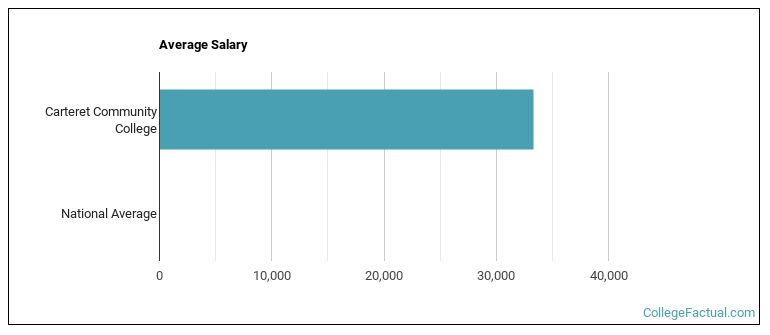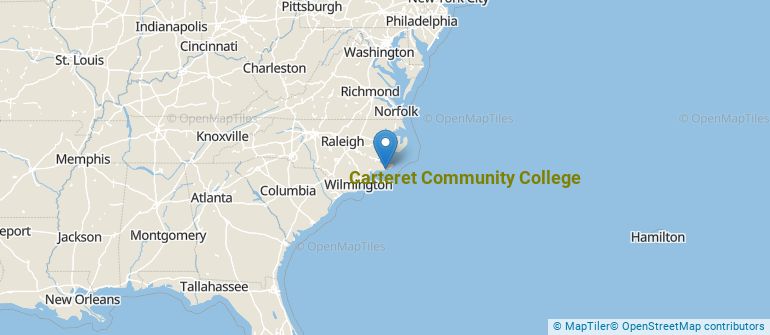 by our College Data Analytics Team
by our College Data Analytics TeamExplore the best ranked schools for the programs you are most interested in.
Carteret Community College is ranked #1,944 out of 2,152 schools in the nation for overall quality on College Factual's 2025 Best Colleges list. This is an improvement over the previous year, when Carteret Community College held the #2,059 spot on the Best Overall Colleges list.
Carteret Community College also holds the #77 spot on the Best Colleges in North Carolina ranking.
Since Carteret Community College has an open admissions policy, being accepted to the school isn't that hard. However, a full basic things - such as a high school diploma or equivalent - may be required. Also, go over your application to make sure it is complete before you submit it.
The student to faculty ratio is often used to measure the number of teaching resources that a college or university offers its students. The national average for this metric is 15 to 1, but at Carteret Community College it is much better at 10 to 1. That's good news for students who want to interact more on a personal level with their teachers.
In addition to the student to faculty ratio, some people look at what percentage of faculty members are full-time as a sign of how much time professors will be able to spend with their students. This is because part-time teachers may not be be on campus as much as their full-time counterparts.
The full-time faculty percentage at Carteret Community College is 20%. This is lower than the national average of 47%.
The freshmen retention rate tells us what percentage of first-year, full-time students choose to continue on to their sophomore year at a particular school. The rate at Carteret Community College is 71%, which is about average when compared to the national rate of 68%.
During the 2017-2018 academic year, there were 1,347 undergraduates at Carteret Community College with 407 being full-time and 940 being part-time.
The net price is calculated by adding tuition, room, board and other costs and subtracting financial aid.Note that the net price is typically less than the published for a school. For more information on the sticker price of Carteret Community College, see our tuition and fees and room and board pages.
The student loan default rate at Carteret Community College is 2.0%. This is significantly lower than the national default rate of 10.1%, which is a good sign that you'll be able to pay back your student loans.
Get more details about paying for Carteret Community College.

See which majors at Carteret Community College make the most money.
Get more details about the location of Carteret Community College.

Contact details for Carteret Community College are given below.
| Contact Details | |
|---|---|
| Address: | 3505 Arendell St, Morehead City, NC 28557 |
| Phone: | 252-222-6000 |
| Website: | www.carteret.edu/ |
| Most Popular Majors | Bachelor’s Degrees | Average Salary of Graduates |
|---|---|---|
| Liberal Arts General Studies | 107 | NA |
| Culinary Arts | 107 | NA |
| Vehicle Maintenance & Repair | 47 | NA |
| Business Administration & Management | 36 | NA |
| Allied Health Professions | 35 | NA |
| Cosmetology | 35 | NA |
| Computer Information Systems | 33 | NA |
| Criminal Justice & Corrections | 33 | NA |
| Mental & Social Health Services | 31 | NA |
| Allied Health & Medical Assisting Services | 27 | NA |
Online learning options are becoming more and more popular at American colleges and universities. Online classes are great for students who have busy schedules or for those who just want to study on their own time.
In 2022-2023, 1,205 students took at least one online class at Carteret Community College. This is an increase from the 1,146 students who took online classes the previous year.
| Year | Took at Least One Online Class | Took All Classes Online |
|---|---|---|
| 2022-2023 | 1,205 | 682 |
| 2021-2022 | 1,146 | 619 |
| 2020-2021 | 977 | 512 |
| 2018-2019 | 579 | 187 |
Learn more about online learning at Carteret Community College.
Footnotes
*The racial-ethnic minorities count is calculated by taking the total number of students and subtracting white students, international students, and students whose race/ethnicity was unknown. This number is then divided by the total number of students at the school to obtain the racial-ethnic minorities percentage.
References
More about our data sources and methodologies.